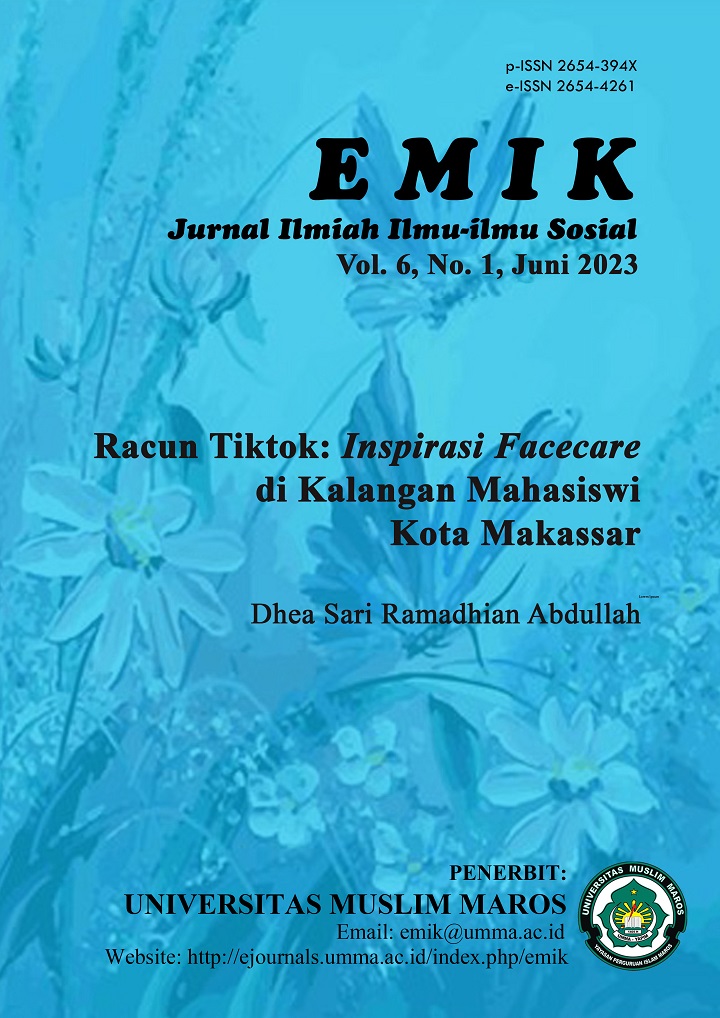Racun Tiktok: Inspirasi Facecare di Kalangan Mahasiswi Kota Makassar
DOI:
https://doi.org/10.46918/emik.v6i1.1782Keywords:
Facecare, skin, TikTok, products, glowing, female studentsAbstract
Technological developments have made the world more borderless, information easier to obtain and in a short time, one of the information media is social media, including TikTok which is booming and provides a lot of information, including information about facecare. Recently, TikTok has become one of the most popular social media which displays not only facecare products, but also tips to contend with facecare.
Using qualitative approach, this research was conducted in the city of Makassar. There are ten female students participated in this study, whose age ranging between 18 and 22 years old and who regularly use TikTok application and perform facecare. Data was collected using the combination of indepth interview and observation.
The study shows that for female students, facecare is a series of activities that use a variety of products to maintain healthy faceskin and to deal with faceskin problems, so that it looks “glowing” (white, shining, smooth textured, and tight), like the skin of Korean artists which reflects the ideal Indonesian women's skin today. Even though there are lots of content presenting facecare products on TikTok, to choose a product, female students first understand their skin type, the variety of facecare products, look for products that are suitable for their skin type. Skin types vary from normal skin, oily skin, combination skin, or sensitive skin. In terms of product variety, facecare consists of two, namely: basic products and advanced products with their respective functions. While the former includes products for cleansing, toning, moisturizing, protecting, eye creaming, the latter consists of masking, seruming, essence, ampouling (ampoules), and acne spotting (acne spots) for those with acne. Uniquely, the facecare products used are not well-known brand facecare products, but new brand products that are popularized by TikTok. Meanwhile, they use trial and error method to find a product that suits their skin. Information and references from TikTok are taken into consideration in choosing facecare products. Female students use social media TikTok as a source of information for facecare because TikTok provides facecare content, because TikTok has reviews of facecare products, and because of peer influence. It is argued in this article that even though TikTok has become a source of information for facecare, the selection of facecare products is highly dependent on the compatibility of one's facial skin.
References
Firamadhina, I. R. dan Krisnani, H. 2020. “Perilaku Generasi Z Terhadap Penggunaan Media Sosial TikTok Sebagai Media Edukasi dan Aktivisme”, Share: Social Work Journal, 10(2): 199-208, https://doi.org/10.24198/share.v10i2.31443, diakses tanggal 15 September 2022.
Juliana, F. R. 2022. “Lapar Mata: Mahasiswi, Kecantikan, dan Perilaku Konsumtif”, Emik, 5(1):1-22, https://doi.org/10.46918/emik.v5i1.1224, diakses tanggal 17 Juni 2022.
Hamid, F. 2012. “Media dan Budaya Populer”, Komunika, 15(1):11-15, http://digilib.mercubuana.ac.id/manager/t!@file_artikel_abstrak/Isi_Artikel_458299509992.pdf, diakses tanggal 11 April 2023.
Hardon, A. dan Idrus, N.I. 2014. “On Coba and Cocok: Youth-Led Drug-Experimentation in Eastern Indonesia”, Anthropology and Medicine, May, 21(2):217-229, https://www.tandfonline.com/doi/full/10.1080/13648470.2014.927417, diakses tanggal 15 Maret 2023.
Irianto dan Hariatingisih, R. L. 2020. “Penggunaan Skincare dan Penerapan Konsep Beauty 4.0 pada Media Sosial: Studi Netnografi Wanita Pengguna Instagram”, Journal Komunikasi,11(2):119-128, https://10.31294/jkom, diakses tanggal 7 Maret 2023.
Larasati, D. 2018. “Globalisasi Budaya dan Identitas: Pengaruh dan Eksistensi Hallyu (Korean Wave) versus Westernisasi di Indonesia”, Jurnal Hubungan Internasional, 11(1):109-120, https://ejournal.unair.ac.id/JHI/article/download/8749/5697, diakses tanggal 11 April 2023.
Naufah, N, M, 2022. Hubungan Antara Regulasi Diri dan Pembelian Impulsif Terhadap Produk Skincare pada Mahasiswa. Skripsi, Fakultas Ilmu Sosial dan Humaniora, Universitas Islam Negeri Sunan Kalijaga, Yogyakarta.
Pujiono, A. 2021. “Media Sosial Sebagai Media Pembelajaran Bagi Generasi Z.”, Didache: Journal of Christian Education, 2(1):1-19, https://doi.org/10.46445/djce.v2i1.396, diakses pada tanggal tanggal 25 Agustus 2022.
Putra, Y. S. 2016. “Theoretical Review: Teori Perbedaan Generasi”, Among Makarti: Journal of Economics and Business, 9(2):123-124, http://dx.doi.org/10.52353/ama.v9i2.142, diakses pada tanggal 18 Agustus 2022.
Putri, N. D., Ayuningtyas. N., Ambarwati. N. S. S 2019. “Faktor-Faktor Keputusan Konsumen dalam Membeli Kosmetika Perawatan Wajah” Jurnal Tata Rias, 9(2):1-8, https://www.researchgate.net/publication/351424474, diakses tanggal 2 September 2022.
Rahma dan Idrus, N.I. 2022. “Tren Glow Up Challenge di Masa Pandemi Covid-19”, Emik, 5(1):22-46, https://ejournals.umma.ac.id/index.php/emik/article/view/1281/890, diakses tanggal 17 Juni 2022.
Rahmawaty, A. 2020. “Peran Perawatan Kulit (Skincare) yang Dapat Merawat atau Merusak Skin Barrier”, BIMFI, 7(1):5-10, https://doi.org/10.48177/bimfi.v7i1.32, diakses tanggal 28 Februari 2023.
Sari, A. T. P, 2016. Kecantikan di Kalangan Mahasiswi Studi Etnografi Tentang Perawatan Kulit untuk Kecantikan Bagi Mahasiswi Kota Makassar. Skripsi, Fakultas Ilmu Sosial dan Ilmu Politik, Universitas Hasanuddin, Makasssar.
Sari, I. P. 2019. Rekonstruksi dan Manipulasi Simbol Kecantikan, Jurnal Hawa, 1(1), 1-18, https://ejournal.iainbengkulu.ac.id/index.php/hawa/article/download/2221/1848, diakses tanggal 11 April 2023.
Sa’roni. 2018. “Pengaruh Globalisasi Terhadap Eksistensi Kebudayaan Daerah”, AVIASI: Jurnal Ilmiah Kedirgantaraan, 15(1):47-75,https://doi.org/10.52186/aviasi.v15i1.5 , diakses tanggal 11 April 2023.
Setiadi, A. 2016. “Pemanfaatan Media Sosial untuk Efektifitas Komunikasi”, Jurnal Humaniora Universitas Bina Sarana Informatika (CAKRAWALA,) 16(2):1-7, https://doi.org/10.31294/jc.v16i2.1283, diakses tanggal 22 Februari 2023.
Setiawati, M. dan Pratiwi, A. 2022. “TikTok Sebagai Media Edukasi Perawatan Kecantikan”, Cakrawala, 5(2):416-430, https://journal.imwi.ac.id/index.php/cakrawala/article/download/113/130, diakses pada tanggal 20 Maret 2023.
Sundawa, Y. A.dan Trigartanti, W. 2018. “Fenomena Content Creator di Era Digital”, Prosiding Hubungan Masyarakat, 438-443, http://dx.doi.org/10.29313/.v0i0.11408, diakses tanggal 22 Maret 2022.
Utami, P. H.; Amanda, N. M.; dan Suryawati, I. G. 2021. Pengaruh Penggunaan #skincareviral di Video TikTok Terhadap Minat Beli Skincare bagi Pengguna TikTok di Denpasar, Medium: Jurnal Ilmiah Mahasiswa Ilmu Komunikasi, 1(1):1-8, https://ojs.unud.ac.id/index.php/komunikasi/article/view/74628, diakses pada tanggal 26 April 2022.
Wahyuningtyas, R. S. T. dan Pratiwi, H. S. 2015. “Sistem Pakar Penentuan Jenis Kulit Wajah Wanita Menggunakan Metode Naïve Bayes”, Jurnal Sistem dan Teknologi Informasi, 1(1):1-6, https://journals.usm.ac.id/index.php/the-messenger/article/view/270, diakses tanggal 11 Januari 2022.
Watie, E. D. 2011. “Komunikasi dan Media Sosial”, The Messenger, III (1):69-75, https://journals.usm.ac.id/index.php/the-messenger/article/view/270, diakses tanggal 11 Januari 2022.
Wiharsari, J. C. 2019. “Konsep Kecantikan dan Pemanfaatan Produk Kosmetik Wajah pada Mahasiswi Surabaya”, Journal Unair, 8(2):1-11, http://repository.unair.ac.id/id/eprint/88341, diakses pada tanggal 26 April 2022, diakses tanggal 11 Januari 2022.
Wijoyo, H.; Indrawan, I.; Handoko, A. L.; dan Santamoko, R. 2020. Generasi Z dan Revolusi Industri 4.0. Jawa Tengah: CV. Pena Persada.










9.png)















